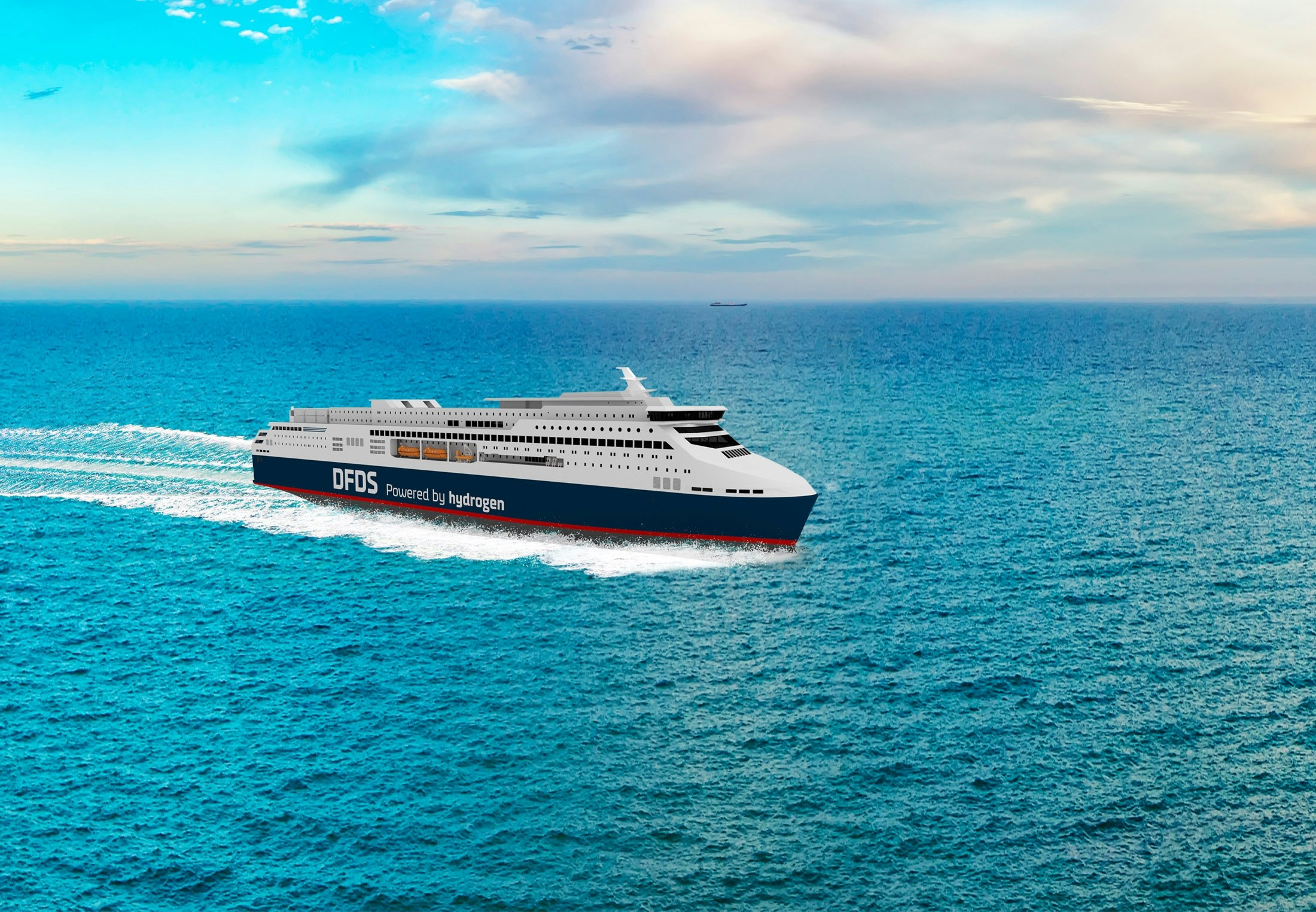In 2027, a 200-meter-long ferry with 1,800 passengers will set sail from the port of Copenhagen, heading for Oslo. But it is not a traditional ferry. At its core, it hides groundbreaking technology: The fuel is hydrogen and the only exhaust emission is water.
Ferries have been powered by bunker oil or diesel-fueled four-stroke engines for decades, but now the climate crisis threatens to force carbon dioxide-spewing engines into retirement.
Instead, a new generation of hydrogen-powered fuel cells is ready to take over the work of propelling the ships’ propellers.
The company behind the project is called Europa Seaways and consists of the shipping company DFDS, the technology company ABB, the ship design company Knud E. Hansen and the energy company Ørsted. They will operate the world’s largest hydrogen ferry regularly between Copenhagen and Oslo.
“We must get away from fossil fuels and instead use fuels that are climate neutral,” explains Jakob Steffensen, head of innovation at DFDS.
The idea is that hydrogen technology will revolutionize the shipping industry and invest in a climate-friendly future, but there are still some clouds on the horizon that prevent the immediate implementation of the technology.
Hydrogen must first be extracted
Today, ships are mainly powered by different variants and degrees of refining of oil. This oil combustion gives rise to climate-damaging gases. More specifically, 2-3 percent of the greenhouse gas emissions worldwide come from the global ship fleet, shows figures from the International Hydrographic Organization.
—
The industry is well aware of the problem and is considering a number of alternatives – of which hydrogen is one of the most promising.
Hydrogen, or hydrogen (H), is the most common element in the universe, so in principle there is plenty of fuel to fill the ferries with. But unlike oil, it is not possible to pump the hydrogen out of the bedrock and pour it into barrels.
Hydrogen is almost always associated with other elements that form new molecules – for example water (H2O) or methane (CH4).
Therefore, the hydrogen must first be extracted. One of the methods is to use electricity to split the water into its two constituents, hydrogen and oxygen, in a reaction called electrolysis.
The process is energy-intensive, and therefore the plan is for the hydrogen to Europa Seaways to be produced with the help of electricity from the offshore wind turbines outside Copenhagen, where the electrolysis plant will be located.
When the hydrogen ferry’s tanks, which hold a total of 44 tonnes of hydrogen, have been filled, the chemical energy in the hydrogen must be converted into electrical energy, which can drive the electric motors and thus the ship’s propellers in the water.
—
So-called fuel cells are installed on Europa Seaways and will produce electricity using the technology proton-exchange membrane (PEM).
A PEM fuel cell resembles a battery. The cell is provided with two electrodes called an anode and a cathode separated by a so-called electrolyte. On the anode side of the cell, each hydrogen atom is split into two hydrogen ions and two electrons.
The hydrogen ions can run straight through the electrolyte and over to the cathode, while the electrons are blocked.
Therefore, the electrons instead run via wires to a battery that is charged and can drive the electric motors on board the ship.
Hydrogen must be compressed
Fuel cells today can typically reach between one and five megawatts of electric power – one megawatts can power 500-700 households depending on consumption. But for Europa Seaways, the cells are scheduled to perform as much as 23 megawatts.
The problem with fuel cells is that they are not very efficient. For PEM fuel cells, the efficiency today is around 50 percent. This means that only about half of the energy in the hydrogen is converted into electricity, while the rest is lost in the form of, among other things, heat to the surroundings.
—
Researchers therefore work with so-called solid fuel cells (SOFC), which use a ceramic material as electrolyte and can achieve an efficiency of at least 60 percent.
Another challenge with hydrogen is that the gas is extremely flammable and at the same time requires a large space in relation to its mass – one kilogram of hydrogen, for example, occupies no less than eleven cubic meters at normal atmospheric pressure.
For a hydrogen car, for example, to be able to drive 100 kilometers, it usually requires exactly one kilo of hydrogen. But if a hydrogen car were to use hydrogen at atmospheric pressure to drive 500-600 kilometers, which is the usual range of a traditional car, it would require a huge fuel tank of 50 times 50 meters.
—
One solution is to cool the hydrogen to -250 degrees Celsius, which makes it liquid so that it requires less space. However, cooling requires large amounts of electricity and insulated hydrogen tanks.
Europa Seaways applies another solution: to compress the hydrogen at a pressure that is 350 times higher than at sea level.
“Hydrogen is black to handle, because it has to be compressed so much for us to be able to take it on board. Today we usually have six fuel tanks on board, but with 350-bar (about 350 times atmospheric pressure, ed. Note). “We get hydrogen tanks up to over 1000 (tanks, editor’s note). It is much more complex”, says Jakob Steffensen.
The solution to that challenge will be to place all the hydrogen tanks under the lowest car deck on board the ferry to make room for 44 tonnes of hydrogen.
Hydrogen reduces carbon dioxide
When Europa Seaways plans to embark on its maiden voyage by 2027, the experience on board should be comparable to changing from a fossil car to an electric car, says Jakob Steffensen.
“You will still hear the ship’s movements in the water and you will still get the maritime experience, but the noise from the ship’s engines will be much lower,” he says.
VIDEO: This is how hydrogen technology works
—
The hydrogen ferry is part of a larger plan for the shipping company DFDS and its fleet of 60 vessels: They will reduce carbon dioxide emissions by 45 percent by 2030 and be completely climate neutral by 2050.
And DFDS may soon be joined by the rest of the shipping industry. In a 2021 questionnaire conducted by the law firm Watson Farley & Williams, industry leaders said they estimate that hydrogen fuel cells will account for ten percent of the total energy estimate within five years, and that the rate will rise to 18 percent over the next ten years.
But what the industry’s own representatives say is one thing – and what is actually realistic is another. There, the OECD organization International Transport Forum (ITF) comes up with concrete, rather optimistic proposals for the coming decades.
With hydrogen – and other alternative fuels such as ammonia – the shipbuilding industry can reduce carbon dioxide emissions by as much as 95 percent in 2035 compared to today.
Ships such as Europa Seaways will thus provide a reduction in carbon dioxide emissions, which corresponds to a shutdown of 185 coal-fired power plants.
—

:quality(80)/cdn-kiosk-api.telegraaf.nl/e5a44b96-31f6-11ec-a666-02d2fb1aa1d7.jpg)
